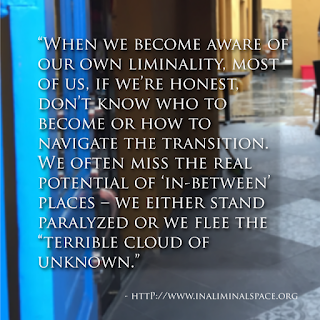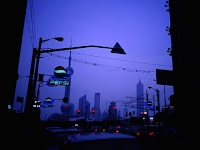All images courtesy of GlowBlog.tumblr.com
What is liminality exactly?
In an essay entitled What is Liminality? author Charles La Shure writes about his study of the writings of Victor Turner, and also expands on these definitions with his own experiences, he states
When I began to write about this, I tried first to look up the word in the dictionary and encountered the above definition, but I knew that there was more to it. The above was too simple, and indeed was a beginning, but there was more it seemed to what it means to me. La Shure further writes:
You will not find the term “liminality” in many dictionaries. In fact, it is not in the Second Edition of the Oxford English Dictionary. The OED does, however, have an entry for “liminal,” the adjectival form, which it lists as a rare usage: “Of or pertaining to the threshold or initial stage of a process.” Both liminal and liminality are derived from the Latin “limen,” which means “threshold."
He develops this idea further in a concise definition of liminality that will inform his future writings: “Liminality may perhaps be regarded as the Nay to all positive structural assertions, but as in some sense the source of them all, and, more than that, as a realm of pure possibility whence novel configurations of ideas and relations may arise” (1967: 97).
In “Liminality and Communitas,” Turner begins by defining liminal individuals or entities as “neither here nor there; they are betwixt and between the positions assigned and arrayed by law, custom, convention, and ceremony” (1969: 95). He then goes on to name the non-structure or anti-structure that he continuously refers to in “Betwixt and Between” through such concepts as the “realm of pure possibility” and structural invisibility.
 | |||
| Quote courtesy of Kasia, author of Terra Incognita Blog. Photo: ©Johnny Perez |
Author and theologian Richard Rohr describes this space as:
where we are betwixt and between the familiar and the completely unknown. There alone is our old world left behind, while we are not yet sure of the new existence. That’s a good space where genuine newness can begin. Get there often and stay as long as you can by whatever means possible…This is the sacred space where the old world is able to fall apart, and a bigger world is revealed. If we don’t encounter liminal space in our lives, we start idealizing normalcy. The threshold is God’s waiting room. Here we are taught openness and patience as we come to expect an appointment with the divine Doctor.
 |
| Quote from www.inaliminalspace.org. Photo: ©Johnny Perez |
In Art & Fear... authors David Bayles and Ted Orland write that making art is dangerous and revealing. They go on to say that the moment of completion [of an artwork] is...inevitably, a moment of loss - the loss of all the other forms the imagined piece might have taken.
Within the moment of creation then, as I see it, is a liminal space in which your ideas and brushstrokes are taking shape and leading to the next form. They are on the cusp, on the precipice to change into something more realized. I'm sure you are aware of this space as an uncertain and frustrating experience, but nonetheless inevitable. This is also a space in which many artists give up. How many times have seemingly good ideas not translated to the paper and end up lost? It can be said that the idea has died, but death is but another word for change. The idea may be exhausted from flying through so much turbulence in the mind so it must change to move on to something better or more evolved, or leads to something entirely new.
 |
| Comic by ©Loryn Brantz |
What Does Liminality Mean to You?
I find it fascinating to explore the meaning of a word that has scarcely been recognized. In searching for meaning I exist within the space I hope to define. While many authors have given their explanations we all still wait for validation of what we find and have always known to be an essential part of creativity. |
| from tumblr: #vaporwave #glitch |
It's no wonder we are surprised at what the final result is from our work at times. The main point I want to drive here is that we are not new to fear, and artist block. The unknown is filled with potential and mysticism. The pain is part of growth, and without that, we are truly stuck. Liminality may be unfinished work, and tossed ideas, and sleepless nights before it metamorphosizes into the masterpiece of tomorrow. But is it not all the act of creation? And what of the actual liminal spaces in our environment, don't they affect us also?
 | ||
| from tumblr: #8bit #vaporwave #glitch |
Some liminal spaces we seek out as artists because we feel something in them, something about them gets the creative juices going. Perhaps they are quiet but not lonely. Perhaps it's your day job after hours, and you stay to work late. I personally like parks with great trees. I also love going to 24-hr diners, and coffee shops when the rush crowds have gone. It may feel to us that we are in "public" thus negating the fact that we are recluses, but we have enough space (and light, and food, and coffee) to let our minds wander. Daydreaming can be very liminal.
Look Further Into Liminal
I encourage you to delve into this interesting concept of "the in-between." At times it can be a bit Twilight Zone but its not a real leap from the creative head space many of us are in daily. There have been numerous art shows around the country exploring liminal art and what it means. I'd say there's plenty of room to define this concept further, if only for yourself. I'd love to know your thoughts on this! Please comment below and let me know what value liminality has for you or what questions you have that maybe we can explore!For many of the quotes I found I searched "liminality in art" on google to find blogs and essays. And for my images, I searched google and tumblr using:
#glow #vaporwave #8bit #glitch #bitwave #abandoned
All of these hashtags and others related have even given way to countless blogs and inspirations boards concerning technology, nostaliga, and abandoned themes. The popularity is related to nostalgia from old cartoons, and videos games, as well as antiquated machines such as the VCR and Cathode-Ray Tube televisions, and these images and objects are given new life. What was once an annoying occurrence, and sign of failing technology (such as glitches and pixelation), is now viewed as art. The old is new. What do you think of this trend? Let me know what you've discovered in the comments!
ENJOY!








No comments:
Post a Comment